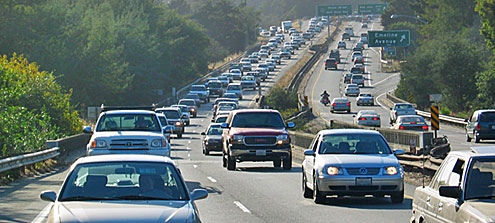Measure D is a sales tax that will fund partially the county’s transportation needs for the next 30 years. It would provide a funding base for other funding sources to match and build upon.
We asked the opinions on the measure from those who support and those who oppose passing Measure D.
•••
Yes on Measure D
Enough is enough. Let’s Get Santa Cruz County Moving — Paul Elerick
For those of us who use Highway 1 and sit in traffic daily, the sense among many is that enough is enough. The time has come to do something about it. Measure D does just that by funding “auxiliary lanes,” which connect onramps to the next off-ramp. These lanes allow Mid County travelers to get on and off Highway 1 faster, and the lanes will give South County commuters a chance to get home sooner.
Auxiliary lanes are already working between the Soquel Dr. and Morrissey Blvd. exits. Measure D adds these lanes in three sections, from State Park to Soquel Dr.
Measure D does a lot more than address Highway 1 traffic. It also funds a new Highway 1 pedestrian/cyclist overcrossing in Seacliff/Aptos at Mar Vista (and one at Chanticleer in Live Oak), local street repairs, safer routes to schools, expansion of the Monterey Bay Sanctuary Scenic Trail, investigation of rail as a possible future transit option (zero funds go to rail service), paratransit services for seniors and those with disabilities, and more.
Today’s highway haters continue to do their best to steer people away from allocating any money to improve congestion on Highway 1. They want us to believe Measure D is all about highway “widening.” Opponents would do nothing to improve congestion on the highway. Their way doesn’t help emergency responders, or hardworking commuters, or small businesses or those using public transit.
The opponents are wrong. I would know. I’m former chair of the Campaign for Sensible Transportation, the folks who oppose the measure. I’ve had concerns in the past about efforts to widen Highway 1, which did not strike the right balance for our community. Measure D, however, hits the mark. The plan smartly invests in traffic relief for Highway 1, while also supporting cycling, street repairs and much more. And Measure D is pro-environment.
Measure D is a practical investment in our future. The measure is a half-cent sales tax, not a bond measure or property tax. The effective rate will actually be a quarter-cent, since a statewide temporary quarter-cent sales tax is ending this year. Measure D also allows Santa Cruz County to join the majority of other counties in California that are eligible for matching funds from the state and federal governments.
The time has come. Let’s look forward, not backward, and get our county moving again. Vote yes on Measure D.
•••
No on Measure D
Santa Cruz County Can Do Better — Campaign for Sensible Transportation
Remember Measure J? Twelve years ago Measure J asked voters to tax themselves an additional half-cent for 30 years to pay for highway widening, pothole repair, senior/disabled transportation, a Pajaro train station, and a coastal trail. Sound familiar? Fifty-seven percent of voters rejected the tax, mostly because it was clear, even in 2004, that 1950’s-style highway widening does not solve traffic congestion, and increased auto travel means more noise, pollution and greenhouse gases.
Here we are again. Measure D again handcuffs together several worthwhile projects with highway expansion. Pro-D advocates claim that their $100 million plan to remove CO2-capturing greenery, install sound walls, and add four miles of auxiliary lanes to the highway is a viable congestion solution. Yet Caltrans has stated that a much larger project than Measure D’s would result in only a “very slight improvement” in congestion relief.
Testing ballot language, the SCCRTC’s voter poll found that respondents favored “improving traffic flow” on Highway 1—but the statement, “adding auxiliary lanes that connect on and off ramps on Highway 1 to reduce cut-through traffic on local streets,” was important to only 49%, even though 86% of respondents were solo drivers for most trips. The results show that while highway congestion relief is desirable, highway expansion is not.
What will help reduce traffic gridlock?
Providing commuters with real alternatives to solo driving to work. Employers are in the best position to offer incentives to modify commuters’ habits, through pre-tax benefits for transit and vanpools, ride-matching, subsidized transit, bike lockers and showers, flex-time, and/or telecommuting. A pilot program in the San Francisco Bay Area removed over 4 million auto trips and eliminated over 85 million miles of vehicle travel in its first 12 months. The program was made permanent last week, and will now include the participation of over 10,000 employers in the Bay Area. Employers can receive payroll tax breaks, and employees receive discounts on the cost of transportation. Highway efficiency increases without increasing sales taxes.
Can we do this in Santa Cruz County? Yes. If County Supervisors were to pass a similar ordinance for employers with 20+ employees, it could provide commuter benefits to 57,640 workers. If they included employers with 10+ employees, it could provide benefits to 69,650 workers in our county. This is how we’ll get moving. Please vote NO on Measure D to defeat this flawed proposal.
